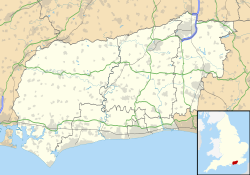| Parham | |
|---|---|
 St Peter's church in Parham Park | |
Location within West Sussex | |
| Area | 15.86 km2 (6.12 sq mi) [1] |
| Population | 214 (2001 Census [1] ) 224 (2011 Census) [2] |
| • Density | 13/km2 (34/sq mi) |
| OS grid reference | TQ060142 |
| • London | 43 miles (69 km) NNE |
| Civil parish |
|
| District | |
| Shire county | |
| Region | |
| Country | England |
| Sovereign state | United Kingdom |
| Post town | Pulborough |
| Postcode district | RH20 |
| Dialling code | 01903 |
| Police | Sussex |
| Fire | West Sussex |
| Ambulance | South East Coast |
| UK Parliament | |
Parham is a civil parish in the Horsham District of West Sussex, England. There was a village of Parham, around the parish church, but its few houses were destroyed in the early 19th century to create the landscaped park and gardens. The parish now consists of Parham Park and the farms and smaller settlements around it. The village is between Wiggonholt and Cootham, about 3 miles (4.8 km) south of Pulborough on the A283 road.
Contents
The parish covers 1,586 hectares (3,920 acres). The 2001 Census recorded 214 people living in 95 households, of whom 124 were economically active. [1] At the 2011 Census the population was 224. [2]
The civil parish includes the hamlets of Rackham, southwest of Parham Park, and Wiggonholt on the A283 to the north, which has a small parish church.
